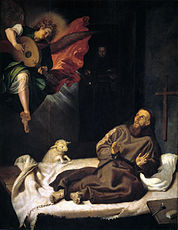
Francis of Assisi
Giovanni di Pietro di Bernardone (c. 1181 – 3 October 1226), known as Francis of Assisi, [b] was an Italian mystic, poet, and Catholic friar who founded the religious order of the Franciscans. Inspired to lead a Christian life of poverty, he became a beggar[7] and itinerant preacher.
This article is about the friar and patron saint. For other uses, see Francis of Assisi (disambiguation).
Francis of Assisi
Giovanni di Pietro di Bernardone
1181
Assisi, Duchy of Spoleto, Holy Roman Empire
3 October 1226 (aged approximately 44 years)
Assisi, Umbria, Papal States[4]
16 July 1228, Assisi, Papal States by Pope Gregory IX
4 October
Franciscan habit, birds, animals, stigmata, crucifix, book, and a skull
Franciscan Order, poor people,[5] ecology, animals, stowaways, merchants, Aguada, Naga, Cebu, Balamban, Cebu, Dumanjug, Cebu, General Trias, Cavite, and Italy
One of the most venerated figures in Christianity,[8][4] Francis was canonized by Pope Gregory IX on 16 July 1228. He is commonly portrayed wearing a brown habit with a rope tied around his waist, featuring three knots symbolizing the three Franciscan vows of poverty, chastity, and obedience.
In 1219, he went to Egypt in an attempt to convert the sultan al-Kamil and put an end to the conflict of the Fifth Crusade.[9] In 1223, he arranged for the first live nativity scene as part of the annual Christmas celebration in Greccio.[c][10][11] According to Christian tradition, in 1224 Francis received the stigmata during the apparition of a Seraphic angel in a religious ecstasy.[12]
He founded the men's Order of Friars Minor, the women's Order of St. Clare, the Third Order of St. Francis and the Custody of the Holy Land. Once his community was authorized by Pope Innocent III, he withdrew increasingly from external affairs.
Francis is associated with patronage of animals and the environment. It became customary for churches to hold ceremonies blessing animals on his feast day of the fourth of October, which became World Animal Day. He is known for devotion to the Eucharist.[13] Along with Catherine of Siena, he was designated patron saint of Italy. He is also the namesake of the American city of San Francisco.
Names[edit]
Francis (Italian: Francesco d'Assisi; Latin: Franciscus Assisiensis) was baptized Giovanni by his mother. His surname, di Pietro di Bernardone, comes from his father, Pietro di Bernardone. The latter was in France on business when Francis was born in Assisi, a small town in Italy. Upon his return, Pietro took to calling his son Francesco ("Free man" or "Frenchman"), possibly in honour of his commercial success and enthusiasm for all things French.[14]
The Franciscan Order promoted devotion to the life of Francis from his canonization onwards, and Francis appeared in European art soon after his death.[92] The order commissioned many works for Franciscan churches, either showing him with sacred figures or episodes from his life. There are large early fresco cycles in the Basilica of San Francesco d'Assisi, parts of which are shown above.
There are countless seventeenth- and eighteenth-century depictions of Saint Francis of Assisi and a musical angel in churches and museums throughout western Europe. The titles of these depictions vary widely, at times describing Francis as "consoled", "comforted", in "ecstasy" or in "rapture"; the presence of the musical angel may or may not be mentioned.[93]
















